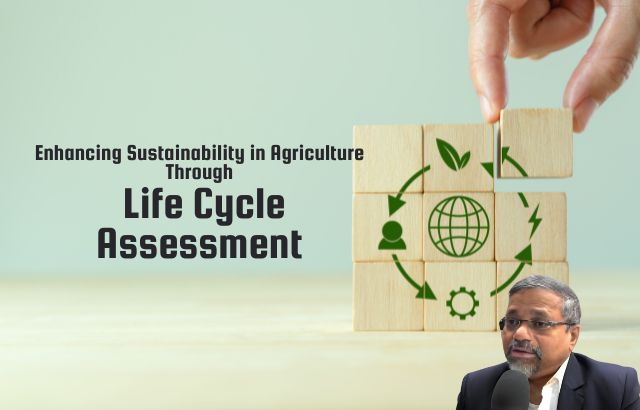In an era where sustainability is becoming increasingly vital, green innovators in agriculture are turning to powerful tools like Life Cycle Assessment (LCA) to optimize their practices and reduce environmental impacts. LCA provides a comprehensive framework for evaluating the environmental effects of agricultural products from cradle to grave. Let’s explore how LCA can revolutionize agricultural practices using practical examples.
Goal and Scope Definition: Setting the Stage for Sustainable Agriculture

The first step in an LCA is defining its goal and scope. For agricultural products, this involves determining what you want to achieve with the assessment and outlining the boundaries of the study.
Example: Suppose a farm wants to assess the environmental impact of growing tomatoes. The goal might be to understand how different cultivation methods affect overall sustainability. The scope would include everything from the production of seeds and fertilizers to the final tomato harvest and distribution to markets.
By clearly defining these parameters, farmers can focus their LCA on relevant aspects and avoid unnecessary complexity. For instance, if the goal is to improve energy efficiency, the scope might emphasize energy use in irrigation and greenhouse operations.
Inventory Analysis: Tracking Inputs and Outputs

Inventory Analysis involves collecting data on all the resources consumed and emissions generated throughout the product’s life cycle. This stage is crucial for understanding the environmental footprint of agricultural practices.
Example: In assessing the sustainability of tomato production, inventory analysis would involve tracking:
- Inputs: Water used for irrigation, fertilizers, pesticides, energy for machinery, and labor.
- Outputs: Tomato yields, waste generated, and emissions from farming equipment.
For a more detailed view, a farm might also track the water footprint and carbon footprint associated with each input. This data helps identify areas where resource use can be minimized or efficiency improved.
Impact Assessment: Evaluating Environmental Effects
Impact Assessment evaluates the environmental consequences associated with each stage of the life cycle. This includes analyzing how inputs and outputs contribute to various environmental impacts such as greenhouse gas emissions, water depletion, and soil degradation.
Example: Continuing with our tomato production example, the impact assessment would quantify:
- Greenhouse Gas Emissions: Emissions from fertilizer production, machinery, and transportation.
- Water Use: The amount of water consumed during irrigation and its potential impact on local water resources.
- Soil Health: Effects of pesticide use and fertilizer application on soil quality.
By assessing these impacts, farmers can pinpoint which stages of production have the highest environmental costs and explore ways to mitigate them.
Interpretation: Making Informed Decisions for Sustainable Practices
The final stage of LCA is interpretation, where the results are analyzed to make informed decisions and drive improvements. This phase involves identifying opportunities for reducing environmental impacts and implementing sustainable practices.
Example: After completing the LCA, a farmer might discover that water usage is the most significant environmental impact in tomato production. In response, they could:
- Adopt Drip Irrigation: A more efficient watering system that reduces water consumption and minimizes runoff.
- Utilize Rainwater Harvesting: Collect and use rainwater to further reduce reliance on external water sources.
- Implement Organic Fertilizers: Reduce the environmental impact associated with synthetic fertilizers.
Through these improvements, the farm not only reduces its environmental footprint but also enhances its overall sustainability and potentially lowers costs.
Life Cycle Assessment in Agriculture -Frequently Asked Questions

What is Life Cycle Assessment (LCA) in agriculture?
Answer: Life Cycle Assessment (LCA) in agriculture evaluates the environmental impacts of agricultural practices from production to disposal, helping farmers improve sustainability.
How does LCA benefit agricultural practices?
Answer: LCA helps identify key areas of environmental impact, allowing farmers to optimize resource use, reduce emissions, and implement sustainable practices.
What are the key stages of LCA in agriculture?
Answer: The key stages of LCA in agriculture are Goal and Scope Definition, Inventory Analysis, Impact Assessment, and Interpretation.
Can LCA help reduce water usage in agriculture?
Answer: Yes, LCA can identify high water usage areas, guiding farmers to adopt efficient practices like drip irrigation and rainwater harvesting to reduce water consumption.
How can farmers use LCA to improve soil health?
Answer: By assessing the impact of fertilizers and pesticides, LCA helps farmers choose practices that minimize soil degradation and enhance soil health.
Life Cycle Assessment in Agriculture – The Path Forward

Life Cycle Assessment is a transformative tool for green innovators in agriculture, offering a clear view of environmental impacts and guiding sustainable decision-making. By carefully defining goals, analyzing inventory data, assessing impacts, and interpreting results, farmers can make meaningful strides towards more sustainable agricultural practices.
As the agricultural sector continues to face environmental challenges, embracing LCA will be essential for driving innovation and fostering a greener future. Whether you’re growing tomatoes or other crops, LCA provides valuable insights that help optimize practices, conserve resources, and ultimately, contribute to a healthier planet.












